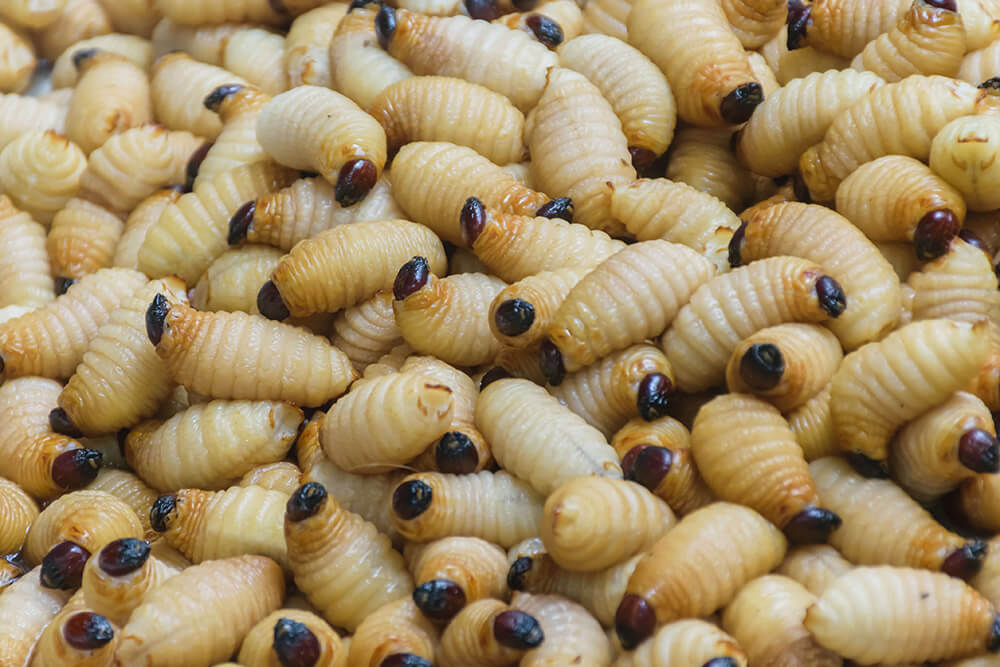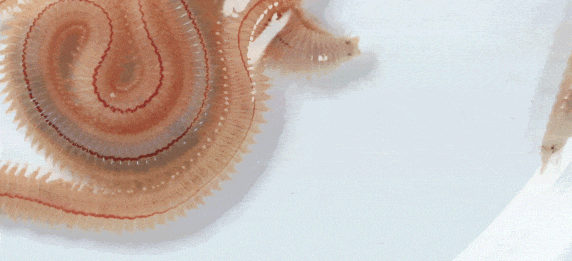For the most part, creepy-crawlies are still outside our culinary horizons – or beneath it, if you want to get technical. Your average European has one reaction to long, slimy invertebrates wriggling through the mud: “Ew!” But any foodie worth their Himalayan pink salt probably ought to quit making faces and get on board – there are countless varieties of worms all over the world, and many methods of preparing them have been around since the dawn of humanity.
“A lot of Europeans are grossed out by worms because that’s just how we’ve done things for the past few generations,”

Christoph Thomann, CEO and founder of Zirp Insects with KTCHNrebel
notes Christoph Thomann, CEO and founder of Zirp Insects; the edible-insect specialists’ product range includes grasshoppers as well as mealworms and buffalo worms. “But our bodies are designed to eat insects, as well as worms.” The reasons for this are pretty self-evident: “Worms are about 60 percent protein. They contain very balanced amounts of the eight essential amino acids. Worms also have an extremely positive omega 3 to omega 6 ratio. They’re high in fiber and very rich in vitamins, including iron, calcium, zinc, and especially Vitamin B. And another nice thing about worms is that you can eat the whole animal.” But which worm varieties are we talking about here, and what’s the best-tasting way of preparing them?
Seasonal worm omelets
European tastebuds – and European eyes – may well find this the most difficult dish to embrace. Nereididae (ragworms) are a family of bristle worms, which is a class of segmented worms. There are over 18,000 different segmented worms, the largest of which is the Giant Gippsland earthworm in Australia (Megascolides australis) – it can grow up to three (!!) meters long. But the culinary delight we’re talking about here is quite a bit smaller (usually ten centimeters or less) and native to Vietnam. Cha Ruoi is the name for this delicate worm omelet whose characteristic flavor comes from its slimy, reddish-yellowish (occasionally pinkish or purplish) star. The first order of business for Hanoi chefs is to get rid of the bristle worms’ surprisingly sharp mini-tentacles, which they do by pouring a whole bowl full of live ragworms into boiling water. The swarming, darting cold-water marine worms quickly settle down after a few moments, and also lose their vivid rainbow hues. Weirdly, though, even after several minutes of cooking and rinsing, the apparently indestructible nereididae are still stretching their little worm-heads towards the heavens. That ends when the chef sprinkles sea salt over the worm pile – and then stirs the mass energetically with a spoon and chopsticks for a minute or so, until all that’s left is a slimy, grayish-green paste. After that, the chef stirs in raw eggs, raw pork, onions, spices, and lime zest, and then fries the tan-and-green puree in a pan that’s at least half-full of oil. The end result looks a little like a potato pancake with a whole lot of parsley in it. Still, Hanoi residents go absolutely nuts over these omelets every fall, when the worms are most abundant.

Image: aon skynotlimit – stock.adobe.com
Squish party
Our next wriggly protagonist has several different names, depending on which part of Sub-Saharan Africa you’re in: phane in Botswana, mashonja in Zimbabwe and parts of South Africa, omangungu in Namibia. In English, it’s called the mopane worm, though it’s technically a moth caterpillar. The name comes from the fact that the yellow-and-blue larvae feed almost exclusively on leaves of the mopane tree, which is widespread throughout this part of the world. Locals collect mopanes by the bucketful, either along streets or just outside villages, and then squish them as a group. Well, “squish” isn’t technically accurate. They squeeze the ends of the larvae, crushing their innards so that a spinach-green liquid squirts out – like if you stepped on a full tube of toothpaste. After that, people in some areas roll them in hot ashes and eat them as a snack; others boil them in salt water or simply dry them. The most well-known method is to saute the mopane worms with tomatoes and onions, and then serve them with millet gruel. This South African dish tastes somewhere between chicken and dried seafood, with a delicate tea-like note that obviously stems from the worms’ mopane-leaf diet. Incidentally, mopane worms are a multi-million-rand industry in Sub-Saharan Africa… Who knows? Maybe they’ll catch on in Europe. “It’s hard to say when Europeans will begin consuming worms regularly,” Christoph Thomann says. “But I’m a hundred percent positive that it will happen.” A majority of those who invest in insect-food projects are assuming it will be a good ten years or so. Thomann himself thinks it will happen sooner. “What appeals to European tastes?” he asks. “That’s the mark we need to hit.” It remains to be seen whether worms will become a taste sensation here in Europe, but at least we know the rest of the world has plenty of recipe suggestions.
Palolo worms
In Hanoi, these bristle worms are boiled, pureed, and served in omelets. They’re considered a street food delicacy.
Earthworms
Definitely under-appreciated in our part of the world. Raw earthworms don’t have a lot of flavor, so worm-cuisine connoisseurs recommend roasting them before using them (for example) as pastry filling. Don’t forget to clean out the dirt inside the worm!
Sago worms
These Southeast Asian delicacies are especially popular in Malaysian cuisine. In Vietnam, they’re often eaten raw, topped with fish sauce.
Mopane worms
In Sub-Saharan Africa, communities get together to squeeze out the spinach-green liquid found inside mopane worms. They’re usually fried and eaten with millet porridge.
Mealworms and buffalo worms
The buffalo worm is like the mealworm’s little brother. Buffalo worms can be eaten steamed, fried, or grilled, but roasting gives them the best flavor – they taste like crunchy chips, with a slightly nutty flavor. Mealworms, on the other hand, are better fried, though they do lose some of their nutty aroma in the process. Both types of worm are widely available dried in our part of the world, and can be used in a variety of ways.












